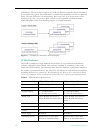
ETV Portal Server Admin Guide 127
Chapter 6
Network Video Recording
Topics in this section
NVR Overview . . . . . . . . . . . . . . . . . . . . . . . . . . . . . . . . . . . . . . . . . . . . . . . . . . . . . . . . . .127
NVR Types. . . . . . . . . . . . . . . . . . . . . . . . . . . . . . . . . . . . . . . . . . . . . . . . . . . . . . . . . . . . . . 129
NVR Installation . . . . . . . . . . . . . . . . . . . . . . . . . . . . . . . . . . . . . . . . . . . . . . . . . . . . . . . . . 130
NVR Configuration . . . . . . . . . . . . . . . . . . . . . . . . . . . . . . . . . . . . . . . . . . . . . . . . . . . . . . . 130
Using an NVR . . . . . . . . . . . . . . . . . . . . . . . . . . . . . . . . . . . . . . . . . . . . . . . . . . . . . . . . . . .131
NVR Overview
The Network Video Recorder (NVR) provides a dedicated platform to perform multiple
simultaneous recordings of live streams coming from VBrick encoders. The NVR lets you
off-load all recording tasks from the ETV Portal Server machine to one or more separate
"recorder server" machines. The NVR provides the ability to record live streams from the
network, store these recorded video files on a specified location (a record server or other
network location), and optionally automatically transfer the contents to selected locations,
and/or ingest them to VOD servers.
The NVR is available in two versions—one that supports 10 simultaneous records and one
that supports 40—and is ideal for environments that require large scale recording on a robust
and reliable platform. The NVR is tightly integrated with the Portal Server, the Scheduler,
and VBrick's Video-on-Demand servers. The NVR provides these standard features.
• Dedicated platform – NVR servers are available on a dedicated hardware platform which
eliminates resource contention and guarantees successful recording.
• Software only – NVR servers are available as a software-only option which you can
install on your own server hardware. See the NVR Release Notes for server hardware
recommendations.
• Redundant storage – both NVR servers offer RAID 5 for storage redundancy as well as
dual power supplies.
• Large storage capacity – the NVR 10 provides 720 GB of storage; the NVR 40 provides
1492 GB.
• Load Balancing – Load balancing is used when multiple NVR servers are installed.
Rather than recording to a specified server, the system records to a dynamically selected
server based on a load balancing algorithm.
• Software Development Kit – VBrick provides an SDK to interface with the Portal Server
or the NVR. In a typical security, surveillance, and monitoring applications application
(without a complete Portal Server), you can write a custom application that will record
streams directly to a standalone NVR.
In a basic Portal Server installation (without an NVR), the standard recording functionality
allows a maximum of two concurrent recordings. In order to expand this recording capability,
you can purchase a Network Video Recorder to offload recording tasks and improve overall


















